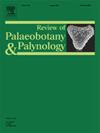末次盛冰期以来滇中地区云南松林的动态变化
IF 1.7
3区 地球科学
Q2 PALEONTOLOGY
引用次数: 0
摘要
近几十年来,气候变化和人类活动对森林的影响加剧,但它们对森林生态系统的相对影响仍然不明确。因此,必须阐明气候变化和人为干扰对不同森林动态的影响。本文以中国西南特有树种云南松(Pinus yunnanensis)为例,利用云南中部4个湖泊集水区的化石松花粉百分比及其估算植物丰度,研究了其自末次冰期极大期(LGM)以来的动态变化。研究结果表明,云南中部YNP森林的动态主要与2万~ 2500 cal. a BP的气候条件有关,而2500 cal. a BP之后YNP森林的动态则受到农业和矿产资源开采加工等人类活动的显著影响。2500 ~ 800 cal. A BP发生了一次长期的大规模森林砍伐,这是人类活动造成的。800 cal. a BP后滇中YNPFs的恢复主要是由于次生植被的自然演替,20世纪末的生态保护政策对YNPFs的恢复有一定的促进作用。季风强度和季节日照驱动的气候条件以及人类活动是控制滇中YNPFs动态的主要因素。特别是在过去2500年中,人类活动对YNPFs的影响变得更加明显。研究结果不仅为认识滇中森林与生态环境、气候变化和人类活动之间的相互关系提供了参考,而且为制定可持续森林经营政策和生态保护战略提供了科学依据。本文章由计算机程序翻译,如有差异,请以英文原文为准。
Dynamics of Yunnan pine (Pinus yunnanensis) forest since the Last Glacial Maximum in central Yunnan, SW China
In recent decades, the influence of climate change and human activities on forests intensified, however, their relative impacts on forest ecosystems remain ambiguous. It is thus essential to elucidate the effects of climate change and human disturbances on the dynamics of different forests. Here we selected the forest of Yunnan pine (YNP) (Pinus yunnanensis), an endemic tree species in Southwest China as an instance, to examine its dynamics since the Last Glacial Maximum (LGM) in central Yunnan where it predominantly occurs, using fossil Pinus pollen percentages and its estimated plant abundances in four lake catchments, central Yunnan. Our study reveals that the dynamics of YNP forests (YNPFs) were principally associated with climatic conditions at 20,000–2500 cal. a BP, whereas the dynamics of YNPFs after 2500 cal. a BP were significantly affected by human activities such as agriculture as well as the extraction and processing of mineral resources in central Yunnan. A long-term and big deforestation occurred at 2500–800 cal. a BP, which was caused by human activities. The restoration of YNPFs in central Yunnan after 800 cal. a BP was predominantly attributed to the natural succession of the secondary vegetation, and reforestation with the aid of ecological protection policies at the end of the 20th century has made its contribution to the recovery of YNPFs in recent decades. Climatic conditions driven by monsoon intensity and seasonal insolation as well as human activities are major factors controlling the dynamics of YNPFs in central Yunnan. Especially, the impact of human activities on YNPFs became more pronounced over the past 2500 years. Our findings not only provide a reference for understanding the interrelationships among forests, ecological environments, climate change, and human activities in central Yunnan, but also offer scientific data for making sustainable forest management policies and ecological conservation strategies.
求助全文
通过发布文献求助,成功后即可免费获取论文全文。
去求助
来源期刊
CiteScore
3.50
自引率
21.10%
发文量
149
审稿时长
6 months
期刊介绍:
The Review of Palaeobotany and Palynology is an international journal for articles in all fields of palaeobotany and palynology dealing with all groups, ranging from marine palynomorphs to higher land plants. Original contributions and comprehensive review papers should appeal to an international audience. Typical topics include but are not restricted to systematics, evolution, palaeobiology, palaeoecology, biostratigraphy, biochronology, palaeoclimatology, paleogeography, taphonomy, palaeoenvironmental reconstructions, vegetation history, and practical applications of palaeobotany and palynology, e.g. in coal and petroleum geology and archaeology. The journal especially encourages the publication of articles in which palaeobotany and palynology are applied for solving fundamental geological and biological problems as well as innovative and interdisciplinary approaches.

 求助内容:
求助内容: 应助结果提醒方式:
应助结果提醒方式:


